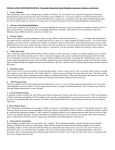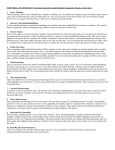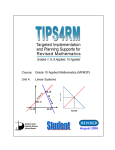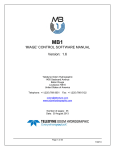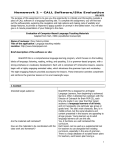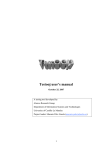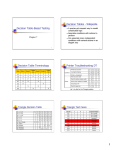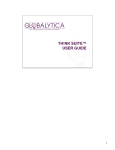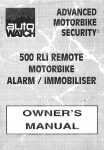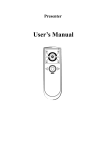Download GEOMETRY/MATH From Kim Huegerich, South Hamilton
Transcript
GEOMETRY/MATH From Kim Huegerich, South Hamilton Community Schools, Jewell, Iowa 1. Process Notes This may be useful for some students who need a structure/process for solving story problems. It helps them to pick out the important information necessary to solve the problem. Write the question. List clue words and facts Identify the variable(s) Make a drawing Choose a strategy Solve the problem Write your answer in a complete sentence that answers the question Check Credibility (does your answer make sense mathematically?) 2. Sequence Organizers This is for step-by-step processes, such as construct an angle congruent to a given angle. The students are the ones becoming the meaning-makers by creating the steps rather than just listening to them or reading them. This could be a recall situation in which they are recreating the steps that they have already done. This forces them to organize the information in order to tell/teach it to another person. You could also have them trade sequence organizers and have them follow the steps to be sure that they work. Step 1 Step 2 Step 3 Step 4 Step 5 Draw a ray with With a compass point With the same compass Open the compass to the Draw ST. endpoint S. on A, draw an arc that setting, put the compass length of BC. Keeping intersects the sides of point on point S. Draw the same compass angle A. Label the an arc that intersects the setting, put the compass points of intersection B ray at point R. point on R. Draw an arc and C. to determine point T. 3. Problem-Solving Organizer Select a problem that has multiple steps (measure parts with metric and English systems). The following graphic is put into a worksheet format. The students can combine written explanation with pictorial explanation such as in a user’s manual. Lastly, the students create a summary about the process. 1. student writes first step here Problem: How to construct a segment congruent to a given segment 2. Student writes second step here 3. Student writes third step here Picture to explain step 1. Picture to explain step 2. Picture to explain step 3. (Summary statement about constructing the segment.) 4. Venn Diagram Helps students see relationships between concepts/vocabulary words. These can be very complex or simple. Straight edge compass protractor Perpendicular bisector angle bisector 5. Concept Map This can be done using pictures as well to help the students figure out an abstract mathematical concept. This could also be paired with Power Thinking. No pairs of parallel sides Quadrilaterals 2 pairs of parallel sides Kite parallelogram 1 pair of parallel sides isosceles Trapezoid Square Trapezoid rhombus rectangle 6. Magnet Summaries Have students discuss all four “magnets” or just 1-2 or a different one each day/piece. Different students/groups could have different magnets. This can be done as a review or to summarize what was just taught. Concept/idea/vocab #1 Concept/idea/vocab #2 acute Main idea Concept/idea/vocab #3 right triangles Concept/idea/vocab #4 obtuse straight 7. Power Thinking After presenting various ways of doing things, concepts, vocabulary, etc. You can give them a list of items and they have to provide the category/main ideas (Power 2) or you can give them the power 1 and power 2s and they provide the details. Offering blank/empty powers provides an aspect of creativity. As long as they can justify their answers they are doing thought-provoking activities. Power 1s may include proofs, angles, shapes, etc. For example, 1.triangles 2.equilateral 3.isosceles 3.scalene 6. equiangular 3.acute 3.right 3.obtuse 8. Selective Underlining/Highlighting As students read a story problem, ask them to highlight the important information. This could be used in conjunction with power thinking, using a different color for each power as they read, or a different color each for addition, subtraction, multiplication, etc. 9. Pattern Puzzles Write out the steps to a process (solving_______ type of problem), cut apart each step and have the students put the steps back in order. Anything that involves a process is a great candidate for pattern puzzles. This can be used to introduce a concept or review a concept. For example, to introduce a process, do the above. Each student/group may come up with a different process. Have them explain why they chose to do it the way they did. You can question their procedure by providing “what if” scenarios based on their process. If there are multiple ways to solve one type of problem and you want to introduce both of them, teach one way first and let them practice and get comfortable with it. Give them a pattern puzzle to solve. Have them explain why they put it together that way. Give them the same problem with a new pattern puzzle solving it using the new way. Although they have not been taught the new way, they are using what they already know (background knowledge) and applying it to a somewhat new situation. 10. Think-Pair-Share This is sometimes called Think-Ink-Pair-Share (TIPS). Anytime you have them do a worksheet or textbook problem, this is an ideal time for this. They think about the answer, “ink” it, share their response with a partner and then share/demonstrate with the whole class. This builds in wait time for the slower students, builds confidence because they are sharing and validating their answers with another student (collaborative work, teamwork skills), possibly even some reciprocal teaching may be going on if their answers don’t agree, and then sharing one thought-out answer with their peers. The key is that the student is doing the processing, not the teacher for the student. 11. Mind Streaming This is a great way to assess the students’ background knowledge. In pairs, a topic is given, such measuring angles, measurement, graphs, etc. One student talks for 1 minute, saying everything s/he knows about the topic. The other student may not say anything, however gestures such as nodding, smiling, etc may be used. At the end of the minute, the roles are reversed. The second student may repeat what the first student said, but again must continue talking for the whole time. 12. Carousel Brainstorming A problem using a new concept is posed to the class. The students work in groups or independently to come up with an answer. Ideas are shared one-by-one as you go around the room (carousel). The ideas can be gathered and used in a later discussion or answers can be discussed right away. 13. Three-Minute Pause After explaining and modeling a new concept, put kids in groups of 3, identifying person A, B, and C. Each student speaks for 1 min. You may choose to do more or less, depending on the topic, objective, personalities of kids. Student A: explains the concept.; Student B: continues the explanation; Student C: asks a question. I encourage my students to ask a question that may know the answer to just ask a question. It makes kids think and verbalize the process one more time! The role of each student may change, such as vocabulary, formula used, how this could be applied in “real life”, etc. This usually works best immediately after an explanation as the brain wants to organize the information, provoking students to talk about it. 14. Read-and-Say Something When reading a complex process or new concept from the textbook, break it into “chunks”. This could be paragraphs or smaller sections between bolded headings. Students read in pairs or small groups. Each reads the chunk and one-by-one the students paraphrase each section. Depending on the text, they could add comments about any connections they make (text to text; text to self, text to world). An alternative to this is to “read-and-write something”. The same concept is there, but they are writing independently, rather than discussing. They can form groups after reading/writing and discuss what they wrote, maybe even add an element of reciprocal teaching. Using only their notes, they can come up with a new text to explain what they read. 15. One-Sentence Summary After explaining a concept or vocabulary word, and giving the students time to work on the idea in class, ask them to summarize what they have learned in one sentence. This can be done on a sticky note or orally as a “ticket out”, or “ticket in” to the room the next day, to ensure brevity in their explanation. It is a quick way to assess whether the students understood your objective. 16. Concentric Circles After discussing the different ways to solve a proof, have each person summarize one of them (no more than 4 usually works best). They write their summary on a note card, paper, etc. In two circles, or two lines facing each other, they use the notes they wrote to explain the proof to the other person. They then trade cards and rotate, moving one person to the left/right. They should have a new proof to explain. The explanation process continues. Rotate. Repeat until all proofs have been reviewed. 1 2 3 4 1 2 3 4 3 4 1 2 3 4 1 2 17. Sticky Note Discussion As students read a text, see a demonstration, hear a process, they write comments, questions, connecting (text to text, text to self, and text to world) statements about what they see/hear. These are later used to answer questions and create deeper discussions. This could be done with homework or as a class explanation. 18. (QAR) Question-Answer Relationships This involves using a textbook or user’s manual and answering questions about what is read. By knowing the type of questions that are asked, the answer can be found quickly. There are two types of questions: In the Book and In my Head. In the Book questions can be divided into two additional types of questions: Right There and Think and Search. These questions can be found in the book, as the name suggests. In my Head can also be divided into two additional types of questions: Author and You and On my Own. These types of questions the student must think a little deeper about them. Often students try to look for an answer that isn’t there. Helping them to realize that a question should come from their background knowledge and not from the book can be a revelation to them. 19. Reciprocal Teaching Anytime a teacher can create a situation/environment in which students are teaching their peers is an ideal situation. We remember 90% of what we teach another person. Getting students to summarize, question, clarify and then predict is how they will teach other students. Anytime a student has a question and you think another student knows the answer or can figure it out, send him/her to that student. It will boost their confidence and force them to go through the process and explanation again. 20. KWL Plus Introduce a new concept/procedure/problem/graph to the students. K: they identify what they already know…this could be from their own experience or what they’ve seen/read in the text W: they will be solving a problem using it so…what do they want (need) to know about this process in particular? L: after it has been practiced….what is new/unique to this tool/procedure? What did they learn, transform, change? The “plus” of this strategy is to get the students to identify categories of information in the K, so that they can identify what they W in order L. 21. Anticipation Guides This gets at what they already know (background knowledge). It can identify misconceptions they have of concepts from previous math courses, previous units, etc. This could be done via a checklist, agree/disagree. This may serve as a pre-/post- test. In between, the students are introduced to the new concept and allowed time to practice it, and then see if they were correct in their original evaluation of the concept. This may be a good way to introduce the postulates, theorems, and constructions. Identification of mathematical symbols may be another use of anticipation guides. 22. Comparison Organizer These are similar to Venn Diagrams, but kids see it a little differently. Sometimes the modifications of presentation will make something “click” with different learning styles. This, like a Venn, helps students see comparisons, similarities and difference between concepts and vocabulary items. These can become very complex in nature. Difference #1 Difference #2 Difference #3 Difference #4 Difference #5 parallelograms Similarity #1 Similarity #2 Similarity #3 Similarity #4 Similarity #5 trapezoids Difference #1 Difference #2 Difference #3 Difference #4 Difference #5 23. Content Frames This is used to see relationships between concepts. Students/class will write comments in each blank explaining the particular item. # of sides # of // sides Solve perimeter Solve area abc xyz triangle rectangle circle rhombus 24. Semantic Feature Analysis This is similar to a content frame, except the students are just identifying whether the shape has each characteristic or not. uses pi to solve equal # sides Has right angles 123 triangle rectangle circle rhombus + has this characteristic - does not have this characteristic 25. Observation Entries Have problem using an easier new concept on the board. As you slowly solve the problem, have the students write what you are doing, making observations about the process. After a few examples (3-5), have them complete a problem using their notes and what they saw you do. Discuss any questions that may arise or have the students teach each other and they discover the process. This is a constructivist view of math and you may need a talented group of kids, but it may be worth a try. 26. You Ought to be in Pictures This is used to imagine what life was like “way back when”. You could show pictures mathematical tools (compasses, levels, computers, calculators, etc) were used at the turn of the century or even a few decades ago, have students guess what they were for, if no longer used or available, describe/explain what replaced that use, the advantages of modern machinery, etc. 27. RAFT (Role, Audience, Format, Topic) Students take on the role of another person or inanimate object. They must describe or explain another operation. For example, a student may choose to be a point (Role) convincing you (Audience) that you have an important function (Topic). This could be done via a persuasive letter (Format). 28. Writing Template This is a quick way to know if students understand the objective. This is similar to a one-sentence summary except they are completing a few sentences in their own words to summarize the lesson/concept. For example…Measurements can be made using a variety of tools, such as ________________. When measuring___________, the best tool for the job would be ________________ because… 29. Frayer Model This strategy uses the characteristics of a vocabulary word or concept. It identifies the essential and nonessential characteristics as well as examples and non-examples. Sometimes overgeneralization takes place so identifying what something is not is better than actually identifying what it is. Essential characteristics Non essential characteristics What it must have What it may have Examples What is it? Definition, in own words 4 sides Rhombus Parallelogram Rectangle Non examples What is it not? Antonym Quadrilaterals Same angles Triangle Circle





